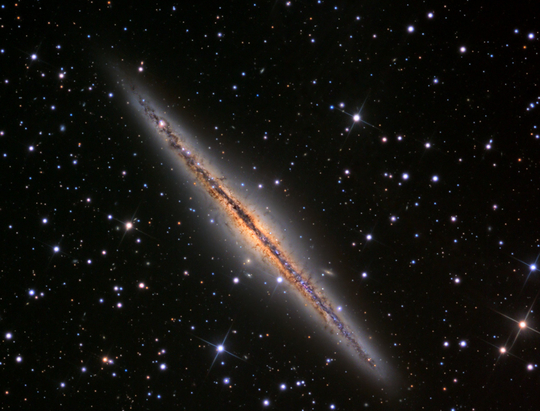October 2012 - Galaxy of the Month
NGC 891 in Andromeda
Image Courtesy of Adam Block / Mount Lemmon SkyCenter / University of Arizona. Click on the image above for a high resolution version.
NGC 891 is one of the finest edge on spirals in the sky. Its discovery was erroneously attributed to Caroline Herschel but it was in fact discovered by her brother William in 1784 where he described it as Bright, large and very much extended
.
Resource on the history of the objects discovered by Caroline are available online.
NGC 891 is about 10 Mpc away and about 100,000 light years across and is part of a group of galaxies that also includes NGC 1023. Although it was first thought to resemble our Milky Way recent observations with the Hubble Space telescope have shown the existence of filaments of dust colloquially known as dust bunnies.
These filaments extend hundreds of lights years above and below the plane of the galaxy. The origin of these is unclear but they may have been thrown up out of the galactic plane by supernova explosions or intense star formation activity. Hubble has some excellent images of these features.
Observations in the Infra-red suggest that the galaxy may have a bar and its classification should perhaps be SBb. The galaxy was chosen as the first light target for both the LBT and the Discovery Channel Telescope. NGC 891 is in many ways similar to our galaxy in that it shows remnants of tidal star streams from the disrupted dwarf galaxies that it has merged with. Robert Gendler provides a view of the galaxy seen through an 8 metre scope.
NGC 891 has also appeared in the start of the TV program the Outer Limits and has had its name taken in at least two music tracks.
The NGC 1023 group consists of the galaxies NGC 891, 925, 1023, 1058 and 1239 along with other much smaller dwarf galaxies. Observationally I find NGC 891 to be a challenge and the ease of seeing it depends very much on the transparency of the sky. I often use it as a test for the transparency.
On good nights it is an ethereal ghost floating in a nice star field. NGC 891 can be seen with small telescopes from very dark skies. Its size lends it to using a medium power eyepiece when viewing. Higher powers will show some of the detail in the dust lane and the nucleus peeping through.
About ¾ of a degree away, although unrelated, is the galaxy cluster AGC 347 with the main galaxy NGC 910.
Owen Brazell - Galaxy Section Director
